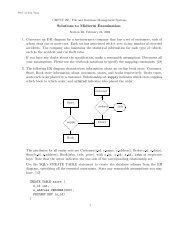CMPUT 340—Introduction to Numerical Methods - Department of ...
CMPUT 340—Introduction to Numerical Methods - Department of ...
CMPUT 340—Introduction to Numerical Methods - Department of ...
You also want an ePaper? Increase the reach of your titles
YUMPU automatically turns print PDFs into web optimized ePapers that Google loves.
<strong>CMPUT</strong> <strong>340—Introduction</strong> <strong>to</strong> <strong>Numerical</strong> <strong>Methods</strong><br />
Assignment 2<br />
Winter 2007<br />
<strong>Department</strong> <strong>of</strong> Computing Science<br />
University <strong>of</strong> Alberta<br />
Due: Sunday, March 4 at 23:59:59 local time<br />
Worth: 15% <strong>of</strong> final grade<br />
Instruc<strong>to</strong>r: Dale Schuurmans, Ath409, x2-4806, dale@cs.ualberta.ca<br />
Note: This assignment is <strong>to</strong> be submitted electronically by using the Unix “astep” command<br />
which is available on the undergraduate machines. You need <strong>to</strong> submit the answers <strong>to</strong> all written<br />
questions in hard copy <strong>to</strong> the course drop box. Matlab functions need <strong>to</strong> be submitted in<br />
.m files (all <strong>of</strong> the Matlab functions required are discussed below). You can submit your files<br />
by typing “astep -c c340 -p a2 file1 file2 ...”. See http://ugweb.cs.ualberta.ca/∼astep<br />
Note: For this assignment you are allowed <strong>to</strong> use the functions in help matfun, but not<br />
those in help optim.<br />
Part 1 (Constraint satisfaction—7%)<br />
(a) (1%) Write a Matlab function [x,flag] = Bisection(f,x0,TOL) which uses the bisection<br />
method <strong>to</strong> find a point x such that f(x) = 0. (See Page 224 in the text.) You<br />
will first have <strong>to</strong> find a bracket (a, b) <strong>of</strong> the solution x that includes the initial point x 0<br />
as one <strong>of</strong> the endpoints (that is, either a = x 0 or b = x 0 ). Try <strong>to</strong> find a solution x with<br />
absolute error bounded by TOL. Return flag = 0 if the subroutine fails and flag = 1 if<br />
it succeeds. Submit the function in a file called “Bisection.m”.<br />
Note that your routine should take the name <strong>of</strong> a function f as the first argument and<br />
call this function at selected points x. You can do this by using the feval command<br />
(see “help feval”). For example, feval(’exp’,2) calls exp on 2 and returns 7.3891.<br />
(b) (1%) Write a Matlab function [x,flag] = SafeNew<strong>to</strong>n1D(f,g,x0,TOL) which combines<br />
bisection with New<strong>to</strong>n’s method <strong>to</strong> find a point x such that f(x) = 0 in a safe<br />
manner. (See Pages 230 and 236 in the text.) Note that the function g must return<br />
the derivative <strong>of</strong> f at points x. Try <strong>to</strong> find a solution x with absolute error bounded<br />
by TOL. Return flag = 0 if the subroutine fails and flag = 1 if it succeeds. Submit the<br />
function in a file called “SafeNew<strong>to</strong>n1D.m”.<br />
1
(c) (1%) Write a Matlab function [x,flag] = SafeSecant1D(f,x0,TOL) which combines<br />
bisection with the secant method <strong>to</strong> find a point x such that f(x) = 0 in a safe manner.<br />
(See Pages 232 and 236 in the text.) Try <strong>to</strong> find a solution x with absolute error<br />
bounded by TOL. Return flag = 0 if the subroutine fails and flag = 1 if it succeeds.<br />
Submit the function in a file called “SafeSecant1D.m”.<br />
(d) (2%) Computer Problem 5.15 on Page 251.<br />
(Use any <strong>of</strong> the techniques implemented above <strong>to</strong> solve the problems specified.)<br />
(e) (2%) Computer Problem 5.28(b) on Page 254. (Note only do Part (b).)<br />
Submit a Matlab function [Ainv] = NewtInv(A) in a file “NewtInv.m”.<br />
Remember <strong>to</strong> submit all written answers in the course drop box.<br />
Part 2 (Optimization—8%)<br />
(a) (2%) Write a Matlab function [x,flag] = LineSearch(f,g,x0,dir,TOL) which finds<br />
a local minimum x <strong>of</strong> the function f along the ray x 0 + αdir starting at x 0 , where dir<br />
is a vec<strong>to</strong>r specifying the direction and α ≥ 0. Note that the function g must return<br />
the gradient <strong>of</strong> f at points x. Return flag = 0 if the subroutine fails and flag = 1 if it<br />
succeeds. Submit the function in a file called “LineSearch.m”.<br />
Note You can implement the line search using any 1-dimensional optimization method<br />
you wish. Some possible choices include golden section search (Page 271), New<strong>to</strong>n’s<br />
method (Page 275) or successive parabolic interpolation (Page 273). This function will<br />
be needed as a subroutine in the two functions below.<br />
(b) (2%) Write a Matlab function [x,flag] = SteepDescent(f,g,x0,TOL) which uses<br />
the steepest descent method <strong>to</strong> find a local minimum x <strong>of</strong> the function f. (See Page<br />
277 in the text.) Note that the function g must return the gradient <strong>of</strong> f at points x.<br />
Return flag = 0 if the subroutine fails and flag = 1 if it succeeds. Submit the function<br />
in a file called “SteepDescent.m”.<br />
Note that you will need <strong>to</strong> call the LineSearch routine implemented above.<br />
(c) (2%) Write a Matlab function [x,flag] = ConjGradient(f,g,x0,TOL) which uses<br />
the conjugate gradient method <strong>to</strong> find a local minimum x <strong>of</strong> the function f. (See Page<br />
283 in the text.) Note that the function g must return the gradient <strong>of</strong> f at points x.<br />
Return flag = 0 if the subroutine fails and flag = 1 if it succeeds. Submit the function<br />
in a file called “ConjGradient.m”.<br />
Note that you will need <strong>to</strong> call the LineSearch routine implemented above.<br />
(d) (1%) Run your steepest descent and conjugate gradient methods on problems defined<br />
by f(x) = 1 2 x⊤ Ax − x ⊤ b + c, where A is a positive semi-definite matrix, b is a vec<strong>to</strong>r<br />
and c is a scalar. (You can construct A using the observation that A = B ⊤ B is positive<br />
semi-definite for any matrix B. Also note that the gradient <strong>of</strong> f is given by Ax − b.)<br />
2
Compare the accuracy, efficiency and robustness <strong>of</strong> the two methods for solving these<br />
problems.<br />
(e) (1%) Use your steepest descent and conjugate gradient methods <strong>to</strong> find the minimum<br />
<strong>of</strong> Rosenbrock’s function f(x, y) = 100(y − x 2 ) 2 + (1 − x) 2 . Try each method from the<br />
starting points [−1 1] ⊤ , [0 1] ⊤ and [2 1] ⊤ . Plot the path taken in the plane by each<br />
method from each starting point.<br />
Remember <strong>to</strong> submit all written answers in the course drop box.<br />
3
Appendix: Exercise descriptions from the textbook<br />
Computer Problem 5.15. (Page 251)<br />
If an amount a is borrowed at interest rate r for n years, then the <strong>to</strong>tal amount <strong>to</strong> be repaid<br />
is given by<br />
a(1 + r) n .<br />
Yearly payments <strong>of</strong> p each would reduce this amount by<br />
n−1 ∑<br />
0<br />
p(1 + r) i = p (1 + r)n − 1<br />
.<br />
r<br />
The loan will be repaid when these two quantities are equal.<br />
(a) For a loan <strong>of</strong> a = $100, 000 and yearly payments <strong>of</strong> p = $10, 000, how long will it take<br />
<strong>to</strong> pay <strong>of</strong>f the loan if the interest rate is 6 percent, i.e., r = 0.06?<br />
(b) For a loan <strong>of</strong> a = $100, 000 and yearly payments <strong>of</strong> p = $10, 000, what interest rate r<br />
would be required for the loan <strong>to</strong> be paid <strong>of</strong>f in n = 20 years?<br />
(c) For a loan <strong>of</strong> a = $100, 000, how large must the yearly payments p be for the loan <strong>to</strong><br />
be paid <strong>of</strong>f in n = 20 years at 6 percent interest?<br />
You may use any method you like [among those you have implemented] <strong>to</strong> solve the given<br />
equation in each case. For the purpose <strong>of</strong> this problem, we will treat n as a continuous<br />
variable (i.e., it can have fractional values).<br />
Computer Problem 5.28(b). (Page 254) (Note only do Part (b).)<br />
New<strong>to</strong>n’s method can be used <strong>to</strong> compute the inverse <strong>of</strong> a nonsingular n × n matrix A. If<br />
we define the function F : IR n×n → IR n×n by<br />
F(X) = I − AX,<br />
where X is an n×n matrix, then F(X) = O precisely when X = A −1 . Because F ′ (X) = −A,<br />
New<strong>to</strong>n’s method for solving this equation has the form<br />
X k+1 = X k − [F ′ (X k )] −1 F(X k )<br />
= X k + A −1 (I − AX k ).<br />
But A −1 is what we are trying <strong>to</strong> compute, so instead we use the current approximation <strong>to</strong><br />
A −1 , namely X k . Thus, the iteration scheme takes the form<br />
X k+1 = X k + X k (I − AX k ).<br />
(b) Write a program <strong>to</strong> compute the inverse <strong>of</strong> a given input matrix A using this iteration<br />
scheme. A reasonable starting guess is <strong>to</strong> take<br />
X 0 =<br />
A ⊤<br />
‖A‖ 1 · ‖A‖ ∞<br />
.<br />
Test your program on some random matrices and compare its accuracy and efficiency<br />
with conventional methods for solving the inverse, such as LU fac<strong>to</strong>rization or Gauss-<br />
Jordan elimination.<br />
4




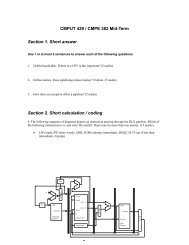

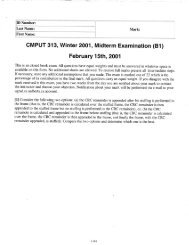
![CMPUT 313 Final Exam [Harms] April 26, 2000 g L (Ilosed Book](https://img.yumpu.com/45617471/1/190x245/cmput-313-final-exam-harms-april-26-2000-g-l-ilosed-book.jpg?quality=85)
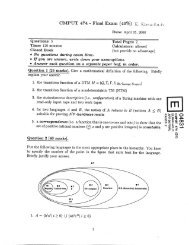
![CMPUT 379 Midterm Exam [Harms]](https://img.yumpu.com/44750568/1/190x245/cmput-379-midterm-exam-harms.jpg?quality=85)



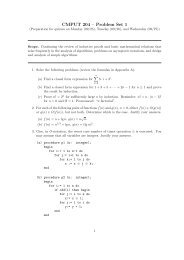

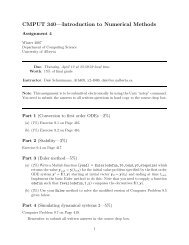
![CMPUT 272 Midterm [B2 -- Harms]](https://img.yumpu.com/36401258/1/190x245/cmput-272-midterm-b2-harms.jpg?quality=85)
